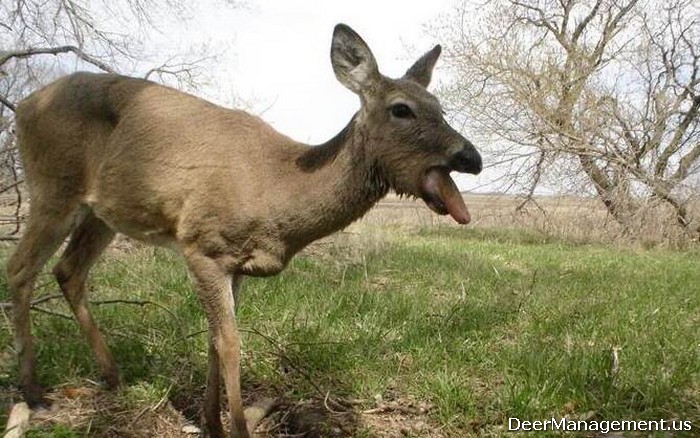Blue Tongue and Epizootic Hemorrhagic Disease (EHD) are viral diseases that impacts farmed and free-ranging white-tailed deer. Though Blue Tongue and EHD are distinctly different, these diseased are sometimes impossible to tell apart. In fact, blood tests results are very similar. For the sake of this article, Blue Tongue and EHD will be used interchangeably. This disease is found most often in sheep, but Blue Tongue has also been found in other livestock such as cattle and goats and other wild ungualtes such as pronghorn antelope and whitetail deer.
White-tailed deer populations have been dealing with these diseases for years, but deer populations continue to hold strong. Blue Tongue and EHD outbreaks in the U.S. occur in deer almost yearly at southern latitudes. EHD and Blue Tongue are spread by midges such as flies or gnats. These insect vectors spread the disease when they bite deer. As a result, outbreaks are virtually untreatable and typically run a course on an annual basis, although weather conditions impact the duration and severity of the outbreak.
Blue Tongue and EHD outbreaks are more noticeable during periods of high temperatures and little rain, but the deer death rate is usually low, with only a small percentage die-off in the population. A deer infected with EHD and Blue Tongue will change its behavior. It will become less careful and seek both shade and water. Some of the symptoms of this deer disease are high fever, excessive salivation, and swelling of the facial area and tongue.
The “blue tongue” that gives the disease its name occurs only in a low number of cases. Symptoms will begin to show within a week after a whitetail deer is bitten and infected with Blue Tongue or EHD virus. Infected whitetail are less fearful of humans, salivate excessively, exhibit peeling or sloughing of the hoof walls, lose their appetite, and do not forage for food. Blue Tongue and EHD induced death can directly come from hemorrhages of the heart or other organs and indirectly from inadequate nutrition/starvation. Hemorrhage and lack of oxygen in the blood results in a blue appearance of the oral mucosa, hence the name “blue tongue.” Blue Tongue and EHD are non-transferable to humans.
In closing, Blue Tongue and EHD are carried by biting insects infected with the disease. Environmental conditions impact the severity of an outbreak and dry periods tend to be the worst. Most episodes are detect during the summer months or drought. Infected deer will often show no fear of humans and often salivate excessively. Eight to 36 hours following the onset of observable signs, deer pass into a shock-like state, become prostrate and die. Whitetail that die from these diseases will often be found in the shade and in or near water sources such as creeks, rivers or tanks.

If you find a deer that has passed away like this, who should you call regarding it?
Can a deer with blue tongue disease be safely harvested? Is their meat edible?
Great article and great pictures. I thought folks interested may also appreciate knowing that HD is not going to wipe out an entire deer population, but it can knock one down significantly.
This is interesting. Let’s hope it’s not as bad as it sounds for the deer in our area.
Question: Can the blue tongue deer disease be contacted by polluted streams?
There is currently an outbreak that has been identified as “Blue Tongue” by the MD Dept of Natural Resources (DNR). It is prevalent in Talbot and Dorchester Counties, both of which are tidal and agricultural. The Sika “Deer” population is also claimed to e effected. The weather during the summer was very wet and rarely above 90 F.
As hunters, we have noticed a significant lack of either species during the hunting seasons thus far this year. Although none of our 6-person hunting group has identified any deer with “Blue Tongue”, there have been Sika Deer in the camp during daytime, which is unusual.
Dennis, sounds like bluetongue has his your area hard. Bluetonge is common in whitetail and some will survive to rebuild the population. Unfortunately, it will take 4-5 years to do so.
Stanley, pollution alone is not going to cause bluetongue, although the midges that transfer the virus between animals are typically found in wet environments which includes streams.
T, yes, it is just fine to consume a deer with bluetongue.
L.K., a deer can die from many causes, so I don’t know that every dead deer warrants a phone call to a DNR/state wildlife agency. It won’t hurt to pick up a phone and give them a shout, however. It would be more appropriate to alert authorities if several deer were found dead within a short time window.